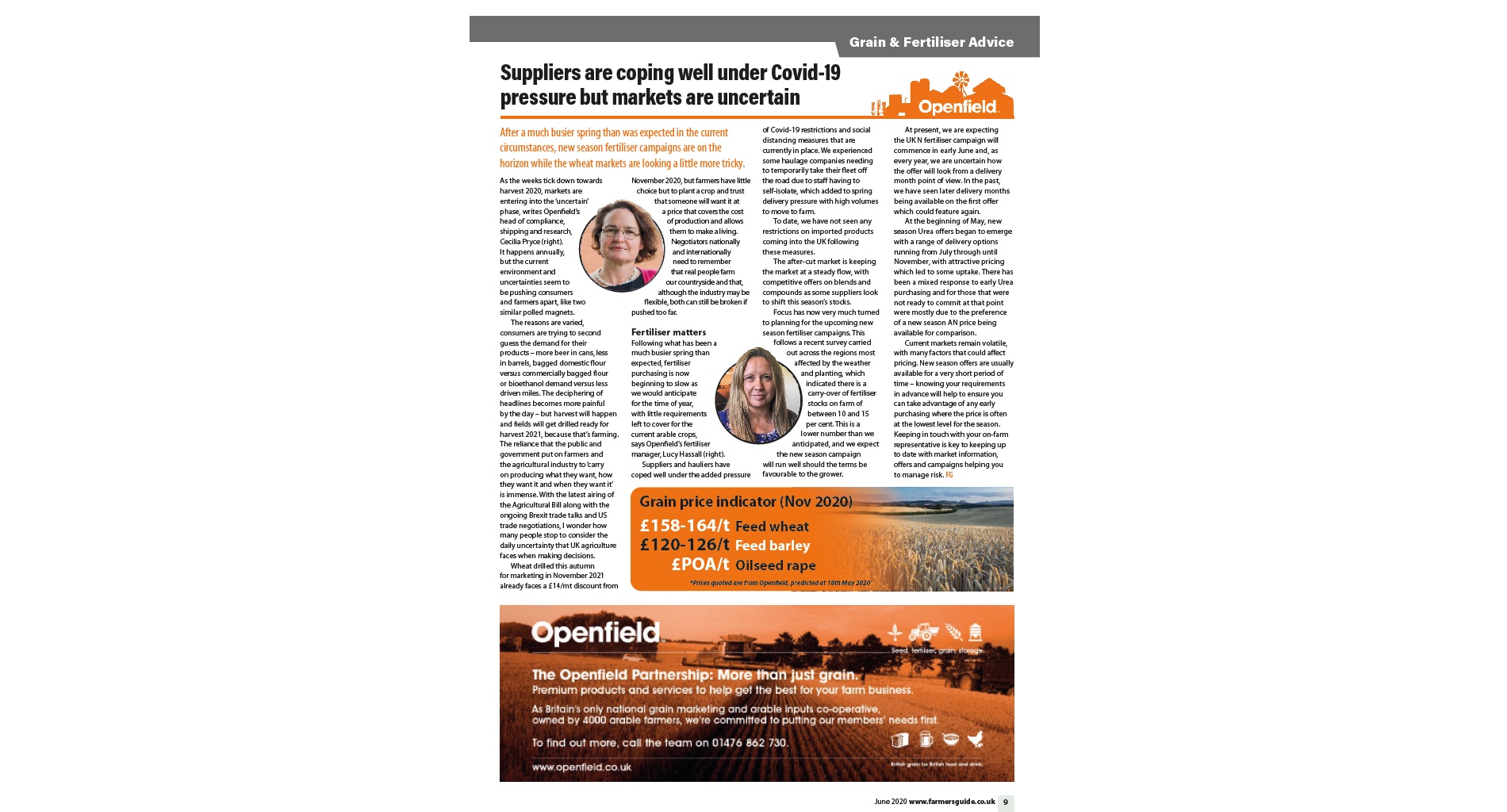Covid-19: Suppliers coping well but markets are uncertain
After a much busier spring than was expected in the current circumstances, new season fertiliser campaigns are on the horizon while the wheat markets are looking a little more tricky.
As the weeks tick down towards harvest 2020, markets are entering into the ‘uncertain’ phase, writes Openfield’s head of compliance, shipping and research, Cecilia Pryce. It happens annually, but the current environment and uncertainties seem to be pushing consumers and farmers apart, like two similar polled magnets.
The reasons are varied, consumers are trying to second guess the demand for their products – more beer in cans, less in barrels, bagged domestic flour versus commercially bagged flour or bioethanol demand versus less driven miles. The deciphering of headlines becomes more painful by the day – but harvest will happen and fields will get drilled ready for harvest 2021, because that’s farming.
The reliance that the public and government put on farmers and the agricultural industry to ‘carry on producing what they want, how they want it and when they want it’ is immense. With the latest airing of the UK Agriculture Bill along with the ongoing Brexit trade talks and US trade negotiations, I wonder how many people stop to consider the daily uncertainty that UK agriculture faces when making decisions.
Wheat drilled this autumn for marketing in November 2021 already faces a £14/mt discount from November 2020, but farmers have little choice but to plant a crop and trust that someone will want it at a price that covers the cost of production and allows them to make a living.
Negotiators nationally and internationally need to remember that real people farm our countryside and that, although the industry may be flexible, both can still be broken if pushed too far.
Fertiliser matters
Following what has been a much busier spring than expected, fertiliser purchasing is now beginning to slow as we would anticipate for the time of year, with little requirements left to cover for the current arable crops, says Openfield’s fertiliser manager, Lucy Hassall.
Suppliers and hauliers have coped well under the added pressure of Covid-19 restrictions and social distancing measures that are currently in place. We experienced some haulage companies needing to temporarily take their fleet off the road due to staff having to self-isolate, which added to spring delivery pressure with high volumes to move to farm.
To date, we have not seen any restrictions on imported products coming into the UK following these measures.
The after-cut market is keeping the market at a steady flow, with competitive offers on blends and compounds as some suppliers look to shift this season’s stocks.
Focus has now very much turned to planning for the upcoming new season fertiliser campaigns. This follows a recent survey carried out across the regions most affected by the weather and planting, which indicated there is a carry-over of fertiliser stocks on farm of between 10 and 15 per cent. This is a lower number than we anticipated, and we expect the new season campaign will run well should the terms be favourable to the grower.
At present, we are expecting the UK N fertiliser campaign will commence in early June and, as every year, we are uncertain how the offer will look from a delivery month point of view. In the past, we have seen later delivery months being available on the first offer which could feature again.
At the beginning of May, new season Urea offers began to emerge with a range of delivery options running from July through until November, with attractive pricing which led to some uptake. There has been a mixed response to early Urea purchasing and, for those that were not ready to commit at that point it was mostly due to the preference for a new season AN price being available for comparison.
Current markets remain volatile, with many factors that could affect pricing. New season offers are usually available for a very short period of time – knowing your requirements in advance will help to ensure you can take advantage of any early purchasing where the price is often at the lowest level for the season.
Keeping in touch with your on-farm representative is key to keeping up to date with market information, offers and campaigns helping you to manage risk.




